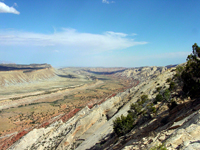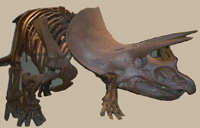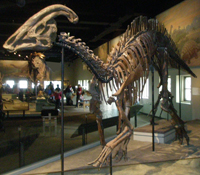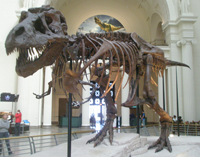2.21: Cretaceous Period (145 to 66 million years)
- Page ID
- 9790
Cretaceous Period (145 to 66 million years)
During the Cretaceous Period the Earth was relatively warm compared to the world today. There were no glaciers on the planet and sea level was as much as 200 feet higher that today. Fossils of warm-water organisms are found in rocks that are arctic regions today. The dinosaurs that survived into the Cretaceous Period diversified and evolved into many unusual forms. Large marine reptiles called Mosasaurs were the dominant organism in the ocean. Sediments deposited in shallow sea flooding onto the continents had an abundance of ammonites—squid-like organisms that had calcareous shells similar to modern nautilus species. Cretaceous gets its name for Creta—Latin for the word chalk. The shallow warm seas of the Cretaceous Period were locations where the calcareous skeletal remains of planktonic organisms called coccoliths accumulated, forming great accumulations of chalk, such as exposed in the Great White Cliffs of Dover, England. In many places in the equatorial realm oyster-like organism called rudists formed great reefs. Flowering plants also first appear in the fossil record, birds existed in Cretaceous time but were insignificant compared to flying non-avian pterosaurs. Small mammals first appear in abundance in the Cretaceous Period, but they were still generally insignificant compared with more dominant reptile and dinosaur species that existed around them.
During Late Cretaceous time, a large mountain range and volcanic arc developed along the western margin of North America as the Atlantic Ocean basin began to rapidly expand. The rising mountains in the west forced an isostatic down warping of the central part of the North American continent, allowing the shallow Western Interior Seaway to flood across much of the region extending from Arctic Ocean in Alaska and Canada to the Texas Gulf Coast region (Figure 2.56).







